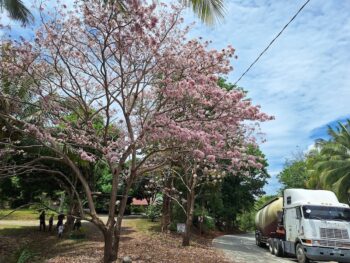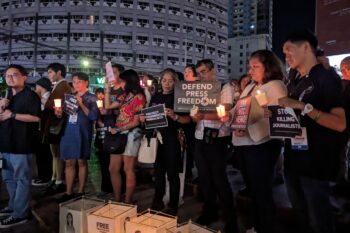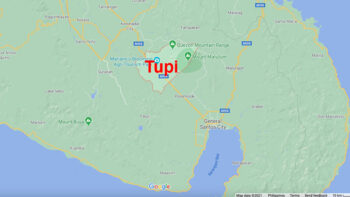
TAGO, Surigao del Sur (MindaNews / 08 January) — I have been to the ancestral house of Fr. Jose Burgos three times. It is one of the major tourist attractions in Vigan City in Ilocos del Sur. The house is smaller than Jose Rizal’s in Calamba, Laguna but it is replete with the necessary conveniences of their time.
The whole house is like a museum that often caught me in wonder and awe, being appreciative of Filipino heritage. It never occurred to me that it is the home of a hero.
Every time I am there, I cannot help but think about him only as a middle class young man who got caught up in Church politics in his time, that earned him and his colleagues the guillotine.
It never crossed my mind how much his life and death impacted the national consciousness that we have now. With his fellow martyrs, my only thought of them was a kind of class of clergy seeking reform from another ‘higher’ class (frayle). And my ignorance was simply crushed after watching the movie, GOMBURZA.
I watched the movie last week with our secretary and we were both crying towards the ending. She commented afterwards: “now I finally understand why they are called martyrs.”
On the other hand, I was utterly speechless and even ashamed of myself to some degree. What can I say? The guy (Fr. Burgos) bluntly preached and taught what he had been formed to and yet he was blatantly rejected, falsely tried, and sentenced to death.
He could have remained as a privileged cleric whose reputation was gradually gaining popular support due to his wit and eloquence. Yet stubbornly, he opted to fight for equality and recognition of rights of his colleagues and people.
In the film, he seemed to find discomfort in the comfort of his privileged status. He didn’t want to teach in Latin as it was a dead language. His desire to put lively discussion in his class led him to breathe life in the colony of decay.
It inevitably behooved me to think about my own comfort and privileges. With the perks of priesthood nowadays, I could have cared less on what is happening with my fellow Filipinos at the grassroots. With secure food on the table always, I could have cared less also for the farmers, fisherfolk, laborers, the Indigenous Peoples, etc. Never mind about the social injustices happening around as long as I have rich and influential families whom I can rely on.
GOMBURZA reminded me the radicality of the gospel that all Christians must follow.
I cried not for the pity I felt for these ill-fated priests but for the bitterness I felt deep inside. I thought GOMBURZA was a team of priests before with shared ideals and goals. But to my surprise, the movie masterfully presented each priest to be distinctly different from one another.
Fr. Mariano Gomes, being advanced in age, has a more subdued character but with a more resolute stance. Fr. Burgos, a pious intellectual, is technically the embodiment of what they were fighting for. Fr. Zamora, a happy-go-lucky one, was but a case of mistaken identity as the film portrayed him to be.
The fate of these diverse characters was eventually intertwined in history as they suffered injustice against a tyrannical regime. What appalled me is not the injustice anymore that happened to them but what is horribly happening still now.
It is bitter to think of a government (or an oppressive regime) inspired by the GomBurZa struggle to trample on rights of the people now. Watching the movie, I cannot help but think about the very same Filipinos tortured, falsely accused, red-tagged, killed, etc., not anymore by the colonizers but by their fellow Filipinos.
The film made obvious that oppression remains; only the face of the oppressors changed. That’s why the revolution continues.
The play of light in the film gladly caught my attention. Most of the time, the movie was shot at night or dawn or in clandestine darkness. The light shone the brightest on the day the “reformer” Governor-General arrived and on the day of the martyrdom (the earlier part).
I would like to believe that GOMBURZA intended to convey something that is the heart of the film – the conception of freedom, independence, and democracy. Rizal and Andres Bonifacio, our national heroes, would carry out its gestation. The birth would come during the 1898 revolution.
There is darkness in the womb during conception but there is a promise of light at birth. But the value of darkness is relative and can be contrasted. The backdrop of darkness among the protagonists “shines” brightly as the dawn of liberation is certainly coming.
On the other hand, the darkness of the evil regime and its cohorts and conspirators is pitch black as perpetual nighttime. The film is nuanced in the period of enlightenment when reason was dubbed superior than faith or power. In the Church, there has never been a dichotomy between faith and reason. The GomBurZa struggle can never be relegated to the sphere of faith alone as the cry for equality, justice, and defense for one’s rights is both universal and religious.
It is up to us individuals now to see the coming of day or to remain in darkness. But precisely, this is what GomBurZa the movie is trying to usher us into as a nation. It is not enough to struggle for one’s identity or sovereignty but we have to be eternally vigilant to protect it.
The fight goes on.
(MindaViews is the opinion section of MindaNews Fr. Raymond Montero Ambray heads the Integral Ecology Ministry, LGBTQ+ Apostolate, Church Heritage and Historical Commission of the Diocese of Tandag. He finished Theology at the Don Bosco Center of Studies and is a graduate of MA Anthropology at the Ateneo de Davao University, a member of the Rural Missionaries of the Philippines and a founding member of Caraga Watch, an environmental watchdog. He is part of the Board of Consultors of the Bishop of Tandag. This reflection was first published on his FB page. MindaNews was granted permission to publish this)







